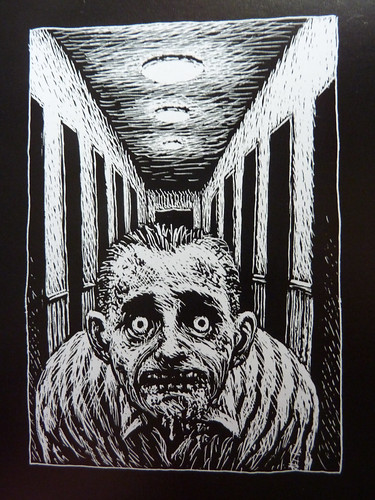Thomas Ott: Scratchboard Graphic Novels

I was looking into more scratchboard artwork with SF themes, and I ran across some images form Thomas Ott’s first length graphic novel. Here is the description on Amazon:
A horrific graphic novel, without words.
Swiss horror master Thomas Ott returns with the first full-length graphic novel of his career. When clearing up the cell of a prisoner who has been sentenced to death and subsequently executed, a prison guard finds a small piece of paper with a combination of numbers on it.
On the spur of the moment, he puts it into his pocket.
As the guard lives a solitary, monotonous life, the numbers on the paper awake his curiosity. To find out their hidden meaning could add a new meaning to his life as well, so the guard stumbles into situations in which the number or part of it seem to achieve a certain importance and offer him hints and possible solutions. And the numbers signal a radical change in his luck. He gets to know a woman, falls in love with her, and one night, in a casino, he wins a huge amount of money when gambling on these numbers.
But the next morning, the woman and money have disappeared.
The man goes in search of the woman and the money. But from that day on, his luck changes and the numbers bring him only bad luck, sending him inexorably into an abyss that he might not recover from. Thomas Ott's O. Henry-esque plot twists will delight fans of classic horror like The Twilight Zone and Tales from the Crypt, or modern masters like filmmaker M. Night Shyamalan; his hallucinatory, hyper-detailed scratchboard illustrations will haunt you long after you've put the book down.
I was sucked in by this image and the overall sense of looming dread Ott can create. SF horror is unique to the genre because it can truly work in the fear of the unknown, and cosmic horror has a realistic sense of turning humans so minuscule in the course of space that it chills us to the bone. The mysteries of the universe can frighten the imagination like other genres cannot.

Here is another image of a more deliberately SF piece:

While here is one that is simply unsettling:















